
Eucalyptus is a genus of over seven hundred species of flowering trees, shrubs or mallees in the myrtle family, Myrtaceae. Along with several other genera in the tribe Eucalypteae, including Corymbia, they are commonly known as eucalypts. Plants in the genus Eucalyptus have bark that is either smooth, fibrous, hard or stringy, leaves with oil glands, and sepals and petals that are fused to form a "cap" or operculum over the stamens. The fruit is a woody capsule commonly referred to as a "gumnut".
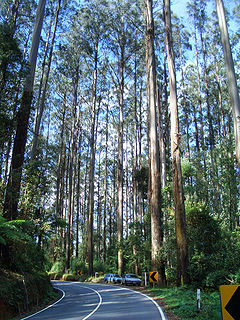
Eucalyptus regnans, known variously as mountain ash, swamp gum, or stringy gum, is a species of medium-sized to very tall forest tree that is native to Tasmania and Victoria, Australia. It is a straight-trunked tree with smooth grey bark, but with a stocking of rough brown bark at the base, glossy green, lance-shaped to curved adult leaves, flower buds in groups of between nine and fifteen, white flowers and cup-shaped or conical fruit. It is the tallest of all flowering plants; the tallest measured living specimen, named Centurion, stands 100.5 metres tall in Tasmania.

Eucalyptus globulus, commonly known as southern blue gum or blue gum, is a species of tall, evergreen tree endemic to southeastern Australia. This Eucalyptus species has mostly smooth bark, juvenile leaves that are whitish and waxy on the lower surface, glossy green, lance-shaped adult leaves, glaucous, ribbed flower buds arranged singly or in groups of three or seven in leaf axils, white flowers and woody fruit.
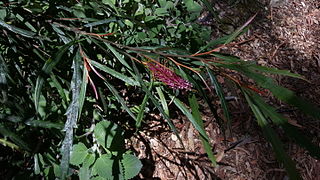
Grevillea longifolia, the fern-leaf spider flower, is a plant of the family Proteaceae, formerly known as Grevillea aspleniifolia. Commonly growing in the Sydney basin of central New South Wales, Australia Grevillea longifolia is recognizable by its deep red "toothbrush" flowers which appear in spring, and narrow, sawtoothed leaves. It is fairly readily grown in gardens.

Eucalyptus cladocalyx, commonly known as sugar gum, is a species of eucalypt tree found in the Australian state of South Australia. It is found naturally in three distinct populations - in the Flinders Ranges, Eyre Peninsula and on Kangaroo Island.
Forest integrated pest management or Forest IPM is the practice of monitoring and managing pest and environmental information with pest control methods to prevent pest damage to forests and forest habitats by the most economical means. Forest IPM practices vary from region to region and particularly by state, according to the habitat and forests present. Forest integrated pest management or Forest IPM combines cultural, biological and chemical technologies to reduce pest damage to levels below those that of economic damage. Forest IPM is utilized for the whole life of the tree, from site prep to harvest. An IPM treatment is utilized before the cost of the treatment is equal to the reduction in crop value due to past injury, which is called the economic injury level. Forest integrated pest management has a strong emphasis on intensive forest management.
Eucalyptus oil is the generic name for distilled oil from the leaf of Eucalyptus, a genus of the plant family Myrtaceae native to Australia and cultivated worldwide. Eucalyptus oil has a history of wide application, as a pharmaceutical, antiseptic, repellent, flavouring, fragrance and industrial uses. The leaves of selected Eucalyptus species are steam distilled to extract eucalyptus oil.
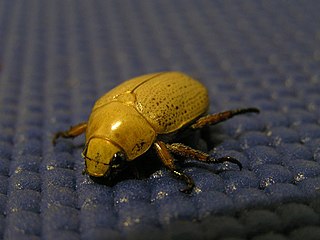
Anoplognathus pallidicollis is a relatively large beetle of the family Scarabaeidae, native to Australia. The beetle has a life span of 24 months and it grows up to 20 mm in length. Adults were once common in the summer months, particularly around Christmas, resulting in the common name of Christmas beetle for the species.

Eucalyptus grandis, commonly known as the flooded gum or rose gum, is a tall tree with smooth bark, rough at the base fibrous or flaky, grey to grey-brown. At maturity, it reaches 50 metres tall, though the largest specimens can exceed 80 metres tall. It is found on coastal areas and sub-coastal ranges from Newcastle in New South Wales northwards to west of Daintree in Queensland, mainly on flat land and lower slopes, where it is the dominant tree of wet forests and on the margins of rainforests.

Eucalyptus oleosa, commonly known as the red mallee, glossy-leaved red mallee, acorn mallee, oil mallee or giant mallee, is a tree or mallee that is native to Australia. The leaves were once harvested for the production of cineole based eucalyptus oil. Eucalyptus cneorifolia is now the predominant strain used in production due to a higher oil content in new growth.

Leptocybe invasa, the blue gum chalcid wasp or eucalyptus gall wasp, is a chalcid wasp which is the only species in the monotypic genus Leptocybe in the subfamily Tetrastichinae, of the family Eulophidae. It is a gall wasp which causes the formation of galls on a number of species of Eucalyptus, it was described in 2004 after galls were found in river red gums in the Mediterranean and Middle East and has since been found to be a widespread species where its host trees are planted. It is indigenous to Australia.

Eucalyptus eugenioides, commonly known as the thin-leaved stringybark or white stringybark, is a species of tree endemic to eastern Australia. It is a small to medium-sized tree with rough stringy bark, lance-shaped to curved adult leaves, Flower buds in groups of between nine and fifteen, white flowers and hemispherical fruit.

Paropsisterna selmani, the Tasmanian Eucalyptus Beetle, is a species of leaf beetle native to Tasmania which has been inadvertently introduced to the Republic of Ireland and United Kingdom. It is the first eucalyptus-feeding chrysomelid known to have become established in Europe.
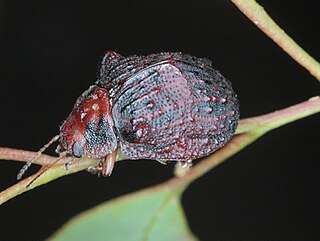
Trachymela is a genus of beetles, commonly called leaf beetles and in the subfamily Chrysomelinae. These beetles are usually brown or black and have elytra with verrucae (bumps) and lacking striae. Trachymela can be found in all states of Australia There are over 120 species.
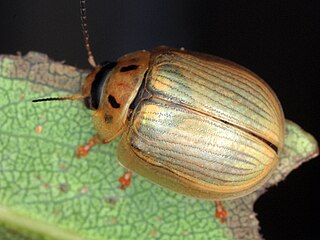
Paropsisterna bimaculata is a beetle commonly called a leaf beetle in the subfamily Chrysomelinae.This insect is common in Tasmania and can be a pest in the forestry industry. Paropsisterna bimaculata will develop a red color just before their winter hibernation. When they emerge the red slowly disappears into a pale green colouring with faint gold tessellation. This takes about a month with the males generally slightly advanced. Recently this beetle has been noticed in Victoria.

Cadmus is a genus of leaf beetles which are commonly called case bearing leaf beetles in the subfamily Chrysomelinae. They are widespread throughout Australia and include 5 subgenera and 68 species.

Eucalyptus occidentalis, commonly known as the flat topped yate or the swamp yate, is a tree that is native to Western Australia. The Noongar names for the tree are Mo or Yundill.
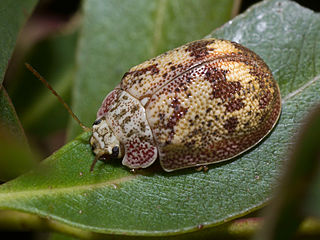
Paropsis charybdis, commonly known as the Eucalyptus tortoise beetle, is a species of leaf beetle belonging to the genus Paropsis. It is considered a pest of some species of Eucalyptus.

















